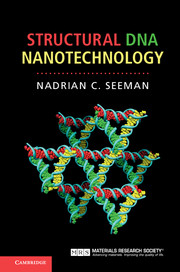Book contents
- Frontmatter
- Contents
- Preface
- 1 The origin of structural DNA nanotechnology
- 2 The design of DNA sequences for branched systems
- 3 Motif design based on reciprocal exchange
- 4 Single-stranded DNA topology and motif design
- 5 Experimental techniques
- 6 A short historical interlude: the search for robust DNA motifs
- 7 Combining DNA motifs into larger multi-component constructs
- 8 DNA nanomechanical devices
- 9 DNA origami and DNA bricks
- 10 Combining structure and motion
- 11 Self-replicating systems
- 12 Computing with DNA
- 13 Not just plain vanilla DNA nanotechnology: other pairings, other backbones
- 14 DNA nanotechnology organizing other materials
- Afterword
- Index
- References
14 - DNA nanotechnology organizing other materials
Published online by Cambridge University Press: 05 December 2015
- Frontmatter
- Contents
- Preface
- 1 The origin of structural DNA nanotechnology
- 2 The design of DNA sequences for branched systems
- 3 Motif design based on reciprocal exchange
- 4 Single-stranded DNA topology and motif design
- 5 Experimental techniques
- 6 A short historical interlude: the search for robust DNA motifs
- 7 Combining DNA motifs into larger multi-component constructs
- 8 DNA nanomechanical devices
- 9 DNA origami and DNA bricks
- 10 Combining structure and motion
- 11 Self-replicating systems
- 12 Computing with DNA
- 13 Not just plain vanilla DNA nanotechnology: other pairings, other backbones
- 14 DNA nanotechnology organizing other materials
- Afterword
- Index
- References
Summary
The initial goals of structural DNA nanotechnology did not stop with the organization of nucleic acid molecules into interesting and attractive shapes, or into lattices. The very first paper in the field had the goal of organizing other molecules into 3D periodic arrays, with the hope that if they were well enough ordered those guest molecules would be susceptible to crystallographic diffraction analysis. Figure 14-1 illustrates this point, where the DNA scaffold is shown in magenta and the guest macromolecule is drawn in turquoise. This motivating goal has yet to be realized in practice, but efforts continue, nearly 35 years after its initial proposal: it is truly a holy grail of structural DNA nanotechnology.
Indeed, one of the earliest subsequent papers suggested that DNA could be used to organize the components of nanoelectronics. Figure 14-2 shows two branched junctions forming a metallic “synapse” from two molecular wires, and Figure 14-3 shows the proposed 3D organization of a 107 Å3 memory element. The structures of the 4-arm and 6-arm junctions illustrated there are not particularly realistic, but the notion that DNA could scaffold the spatial organization other species of molecules was reinforced by these suggestions. As we will see below, the organization of nanoelectronic components by DNA remains an attractive goal.
Control of polymer topology. One of the earliest attempts involving nucleic acids and heteromolecules entails the use of DNA to direct the topology of industrial polymers. The initial experiments in this program entailed hanging alternating pendent diamino and dicarboxyl groups off the 2′ position of RNA molecules (the atom furthest from the helix axis in A-form RNA) so as to direct their topology. Although novel topological species have not yet been produced by this approach, this system has been used to demonstrate the templated 2′, 2′ ligation of nucleic acids that produces a peptide bond. Likewise, it has been used to generate topological targets with connectivity parallel to the helix axis. The catenane produced by joining one amine with one carboxyl group is illustrated in Figure 14-4.
Metallic nanoparticles. The advent of metallic and semiconducting nanoparticles has spurred a lot of effort to organize them by DNA. Very early attempts to assemble nanoparticle clusters were performed by Alivisatos and his colleagues, as well as by Mirkin and his collaborators. These approaches fundamentally used DNA as “smart glue” to put DNA-coated nanoparticles together.
- Type
- Chapter
- Information
- Structural DNA Nanotechnology , pp. 231 - 247Publisher: Cambridge University PressPrint publication year: 2016



